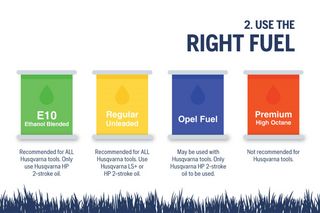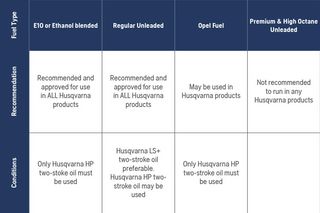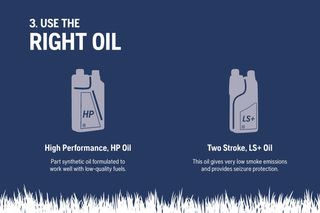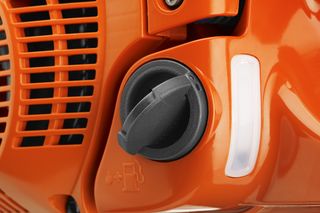
How to mix 2 stroke fuel
Unlike a four-stroke engine, a unique feature of a two-stroke engine is that they do not have an internal oil reservoir. Instead, two-stroke engines require the owner to mix oil into the fuel at a predetermined ratio in order to ensure the engine receives adequate lubrication during operation.
Two-stroke engine lubrication
The first true two-stroke engines were introduced more than a century ago and used to power motorcycles. These days, you’ll find two-stroke engines in all kinds of equipment, such as chainsaws, grass trimmers and hedge trimmers, largely because two-stroke engines have fewer moving parts, generate less heat and are in many ways more efficient for their size.
When it comes to engine lubrication, the difference between a two-stroke and four-stroke engine is that a two-stroke engine has no valve train, timing gears, cams or pushrods, whereas four-stroke engines do. A four-stroke engine needs to circulate oil throughout to lubricate these moving parts, where as a two-stroke engine only needs to lubricate the components internal of the combustion chamber, which can be achieved by simply mixing oil in to the fuel it runs on.
Starting with a safe fuel storage container
The leading cause of contaminated fuel in Australia is dirty fuel storage containers. For this reason, it is essential fuel is stored in a clean container specifically designed to carry fuel.
While fuel jerry cans are great, newer specialist fuel containers to the market such as the Husqvarna Combi Can have been designed to make storage safer and refueling less messy, thanks to inclusions such as the no spill valves, on-board tool storage and dedicated tank for two-stroke oil.

Choosing the right unleaded fuel
When selecting the type of unleaded fuel you use, you’ll need to consider the following.
Only Husqvarna HP or LS+ two stroke oil should be used in Husqvarna products. Husqvarna HP two-stroke oil must be used when mixing E10 fuel. Husqvarna LS+ oil should be used when mixing regular unleaded fuel.

Here's a handy table that helps explain what two-stroke oil to use with each type of fuel.

Choosing the right two-stroke oil
You’ve got your clean, empty fuel can and a good supply of fresh petrol. Now it’s time to make the most important call of them all - choosing the right oil for your two-stroke fuel mix. Husqvarna offers two types of two-stroke oil:
High Performance, HP oil: (544 0158-09, 1 litre dosage bottle)
Husqvarna's HP two-stroke oil is formulated to work well with low-quality fuels. Carefully selected components in this part synthetic oil gives a cleaner engine and less coating on the piston/cylinder walls, exhaust port and crankcase.
Two Stroke, LS+ oil: (578 0370-02, 1 litre carton of 12)
The Low Smoke+ oil is a mix of mineral and synthetic oils. This oil gives very low smoke emissions, especially important when used in products often run in densely built up areas. It also provides a lower engine temperature which extends the engine’s life. The formulation used in Husqvarna Low Smoke + oil also provides seizure protection, both against lean as well as carbon related piston seizures.
As a general warning, never use two-stroke oil intended for water-cooled engines in a non water-cooled engine. Sometimes referred to as Outboard oil (rated TCW). And also never use oil intended for four stroke engines.
Mineral oils usually cost less than synthetics and are great for engine lubrication. While oils made from a natural petroleum base do a fair job of cleaning and filtering engine contaminants, they can leave behind heavier deposits than their synthetic counterparts.
Over time, you may end up with burnt carbon or gummy residue buildup on the piston which can lead to more maintenance and compromised performance. So manufacturers often mix in additives that help improve combustibility.
Full synthetic oils demonstrate superior combustion characteristics on top of delivering great lubrication. With little to none of the mess that a petroleum based oil can leave behind, leaving you with a much cleaner engine. They’re generally formed from a mineral base. Plus additives like octane enhancers, detergents and stabilisers to help burn cleaner than other engine oils. And produce much less smoke.
Semi-synthetic oil meets you in the middle. They’re primarily comprised of high-quality mineral oil. But mixed with additives and synthetic polymers to deliver a cleaner burn than a strictly petroleum based product. Semi-synthetics cost less than full synthetic oils, offer good combustion properties and give you better lubrication than you’d get from a standard, low quality mineral oil.

Two-stroke fuel ratios explained
It’s important to get your fuel-to-oil ratios right when mixing two-stroke fuel. Too much oil, and your engine may struggle to start or run, generate carbon buildup on engine internals, blow clouds of smoke and perform poorly in general. Too little oil, and your engine may sustain permanent internal damage and overheat.
Husqvarna two stroke engines require a two stroke oil designed and formulated for high performance, air-cooled two stroke engines. Husqvarna two stroke engines are designed to run on clean, fresh, unleaded petrol.
A fuel / oil ratio of 50:1 is recommended for all Husqvarna 2-stroke products.
Also consider;
- 50:1 (2%) fuel / oil mix ratio is recommended with the use of genuine Husqvarna two-stroke oil for best performance.
- Mixed fuel must be used within 30 days from the time it was mixed to ensure the fuel is stable and combustible.
Top tips for mixing two-stroke fuel
- Avoid storing mixed two-stroke fuel for more than one month.
- If you do need to prolong the life of your two-stroke fuel mix, there are fuel stabilisers that can be added which may extend the shelf life up to twelve months. Read the label carefully.
- Always clean your cap and the surrounding area before filling up to prevent dirt and debris from falling into your tank.
- Use a clean airtight container intended for fuel. Not only will it prolong the shelf life of your fuel mix, but it can also help prevent spillage, permeation and evaporation.
- Always start by filling half the amount of the petrol to be used. Then add the entire amount of oil. Mix (shake) the fuel mixture. Add the remaining amount of petrol.
- Don’t leave premixed two-stroke fuel in any tool for an extended period of time. Drain tanks and run your tool out of fuel before putting it away.
- Get yourself a small, separate jerry can to store your two-stroke fuel in. So as never to confuse it with your regular, unleaded fuel used in four-stroke engines.
- Always consult your nearest Husqvarna dealer if you are unsure about the correct use of your two-stroke product.











